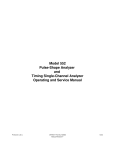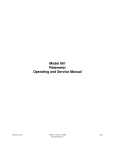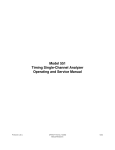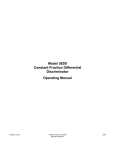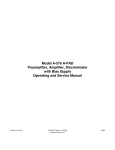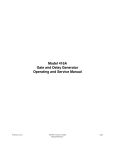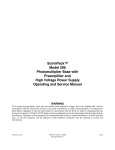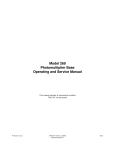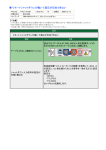Download Models 9301 and 9301S Fast Preamplifiers Operating and
Transcript
Models 9301 and 9301S
Fast Preamplifiers
Operating and Service Manual
Printed in U.S.A.
ORTEC® Part No. 733680
Manual Revision B
1202
Advanced Measurement Technology, Inc.
a/k/a/ ORTEC®, a subsidiary of AMETEK®, Inc.
WARRANTY
ORTEC* warrants that the items will be delivered free from defects in material or workmanship. ORTEC makes
no other warranties, express or implied, and specifically NO WARRANTY OF MERCHANTABILITY OR
FITNESS FOR A PARTICULAR PURPOSE.
ORTEC’s exclusive liability is limited to repairing or replacing at ORTEC’s option, items found by ORTEC to
be defective in workmanship or materials within one year from the date of delivery. ORTEC’s liability on any
claim of any kind, including negligence, loss, or damages arising out of, connected with, or from the performance
or breach thereof, or from the manufacture, sale, delivery, resale, repair, or use of any item or services covered
by this agreement or purchase order, shall in no case exceed the price allocable to the item or service furnished
or any part thereof that gives rise to the claim. In the event ORTEC fails to manufacture or deliver items called
for in this agreement or purchase order, ORTEC’s exclusive liability and buyer’s exclusive remedy shall be release
of the buyer from the obligation to pay the purchase price. In no event shall ORTEC be liable for special or
consequential damages.
Quality Control
Before being approved for shipment, each ORTEC instrument must pass a stringent set of quality control tests
designed to expose any flaws in materials or workmanship. Permanent records of these tests are maintained for
use in warranty repair and as a source of statistical information for design improvements.
Repair Service
If it becomes necessary to return this instrument for repair, it is essential that Customer Services be contacted in
advance of its return so that a Return Authorization Number can be assigned to the unit. Also, ORTEC must be
informed, either in writing, by telephone [(865) 482-4411] or by facsimile transmission [(865) 483-2133], of the
nature of the fault of the instrument being returned and of the model, serial, and revision ("Rev" on rear panel)
numbers. Failure to do so may cause unnecessary delays in getting the unit repaired. The ORTEC standard
procedure requires that instruments returned for repair pass the same quality control tests that are used for
new-production instruments. Instruments that are returned should be packed so that they will withstand normal
transit handling and must be shipped PREPAID via Air Parcel Post or United Parcel Service to the designated
ORTEC repair center. The address label and the package should include the Return Authorization Number
assigned. Instruments being returned that are damaged in transit due to inadequate packing will be repaired at the
sender's expense, and it will be the sender's responsibility to make claim with the shipper. Instruments not in
warranty should follow the same procedure and ORTEC will provide a quotation.
Damage in Transit
Shipments should be examined immediately upon receipt for evidence of external or concealed damage. The carrier
making delivery should be notified immediately of any such damage, since the carrier is normally liable for damage
in shipment. Packing materials, waybills, and other such documentation should be preserved in order to establish
claims. After such notification to the carrier, please notify ORTEC of the circumstances so that assistance can be
provided in making damage claims and in providing replacement equipment, if necessary.
Copyright © 2002, Advanced Measurement Technology, Inc. All rights reserved.
*ORTEC® is a registered trademark of Advanced Measurement Technology, Inc. All other trademarks used
herein are the property of their respective owners.
iii
CONTENTS
WARRANTY . . . . . . . . . . . . . . . . . . . . . . . . . . . . . . . . . . . . . . . . . . . . . . . . . . . . . . . . . . . . . . . . . . . . . . . ii
SAFETY INSTRUCTIONS AND SYMBOLS . . . . . . . . . . . . . . . . . . . . . . . . . . . . . . . . . . . . . . . . . . . . . . . iv
SAFETY WARNINGS AND CLEANING INSTRUCTIONS . . . . . . . . . . . . . . . . . . . . . . . . . . . . . . . . . . . . . v
1. DESCRIPTION . . . . . . . . . . . . . . . . . . . . . . . . . . . . . . . . . . . . . . . . . . . . . . . . . . . . . . . . . . . . . . . . . . . 1
2. SPECIFICATIONS . . . . . . . . . . . . . . . . . . . . . . . . . . . . . . . . . . . . . . . . . . . . . . . . . . . . . . . . . . . . . . . .
2.1. PERFORMANCE . . . . . . . . . . . . . . . . . . . . . . . . . . . . . . . . . . . . . . . . . . . . . . . . . . . . . . . . . . . . .
2.2. CONNECTORS . . . . . . . . . . . . . . . . . . . . . . . . . . . . . . . . . . . . . . . . . . . . . . . . . . . . . . . . . . . . . .
2.3. ELECTRICAL AND MECHANICAL . . . . . . . . . . . . . . . . . . . . . . . . . . . . . . . . . . . . . . . . . . . . . . . .
1
1
1
1
3. INSTALLATION . . . . . . . . . . . . . . . . . . . . . . . . . . . . . . . . . . . . . . . . . . . . . . . . . . . . . . . . . . . . . . . . . .
3.1. CONNECTION TO DETECTOR . . . . . . . . . . . . . . . . . . . . . . . . . . . . . . . . . . . . . . . . . . . . . . . . . .
3.2. CONNECTION OF OUTPUT . . . . . . . . . . . . . . . . . . . . . . . . . . . . . . . . . . . . . . . . . . . . . . . . . . . .
3.3. INPUT POWER . . . . . . . . . . . . . . . . . . . . . . . . . . . . . . . . . . . . . . . . . . . . . . . . . . . . . . . . . . . . . .
3.4. PHYSICAL LOCATION . . . . . . . . . . . . . . . . . . . . . . . . . . . . . . . . . . . . . . . . . . . . . . . . . . . . . . . .
2
2
2
2
2
4. OPERATING INSTRUCTIONS . . . . . . . . . . . . . . . . . . . . . . . . . . . . . . . . . . . . . . . . . . . . . . . . . . . . . . . 2
5. MAINTENANCE AND REPAIR . . . . . . . . . . . . . . . . . . . . . . . . . . . . . . . . . . . . . . . . . . . . . . . . . . . . . . . 3
iv
SAFETY INSTRUCTIONS AND SYMBOLS
This manual contains up to three levels of safety instructions that must be observed in order to avoid
personal injury and/or damage to equipment or other property. These are:
DANGER
Indicates a hazard that could result in death or serious bodily harm if the safety instruction is
not observed.
WARNING
Indicates a hazard that could result in bodily harm if the safety instruction is not observed.
CAUTION
Indicates a hazard that could result in property damage if the safety instruction is not
observed.
Please read all safety instructions carefully and make sure you understand them fully before attempting to
use this product.
In addition, the following symbol may appear on the product:
ATTENTION – Refer to Manual
DANGER – High Voltage
Please read all safety instructions carefully and make sure you understand them fully before attempting to
use this product.
v
SAFETY WARNINGS AND CLEANING INSTRUCTIONS
DANGER
Opening the cover of this instrument is likely to expose dangerous voltages. Disconnect the
instrument from all voltage sources while it is being opened.
WARNING Using this instrument in a manner not specified by the manufacturer may impair the
protection provided by the instrument.
Cleaning Instructions
To clean the instrument exterior:
! Unplug the instrument from the ac power supply.
! Remove loose dust on the outside of the instrument with a lint-free cloth.
! Remove remaining dirt with a lint-free cloth dampened in a general-purpose detergent and water
solution. Do not use abrasive cleaners.
CAUTION To prevent moisture inside of the instrument during external cleaning, use only enough liquid
to dampen the cloth or applicator.
!
Allow the instrument to dry completely before reconnecting it to the power source.
vi
1
ORTEC 9301 and 9301S
FAST PREAMPLIFIERS
1. DESCRIPTION
The ORTEC 9301 and 9301S Fast Preamplifiers
are designed for use in fast timing system
applications. They feature very low noise and fast
risetime to facilitate precise timing measurements.
Their small size and light weight permit them to be
used in close proximity to the detectors they serve,
and this minimizes noise in the output signals. The
two Preamplifiers are identical except for the
mating power connector at the remote end of the
power cable. Although the reference in this manual
is to the 9301, the instructions also relate to the
9301S.
The 9301 can be used with photomultipliers,
electron multipliers, and other detectors that are
employed in photon counting or ion counting
techniques. When the preamplifier is connected to
the detector, the 50 input impedance of the 9301
becomes the load resistance for the detector output
current pulse.
S
The risetime of the 9301 output pulse is <1.5 nsec
and the voltage gain is 10. This combination
ensures the user that each input pulse from the
detector will rise quickly through a normal
discriminator threshold for a precise timing
identification. The voltage gain of 10 also enhances
the signal-to-noise ratio for the system.
Power for operation of the 9301 must be obtained
from either the instrument to which its output pulses
are furnished or from an ORTEC 114 Preamplifier
Power Supply. A 10-ft power cable is built into the
unit and terminated with an Amphenol 17-20090
plug. The Amphenol plug is compatible with the
Preamp power source on a 114 Preamplifier Power
Supply, a 9302 Amplifier/Discriminator, or any
ORTEC NIM-standard amplifier module. For the
9301S the power cable is terminated with a DIN
plug, compatible with the ORTEC Brookdeal 5C1
Photon Counting System.
2. SPECIFICATIONS
Output Connector BNC, rear panel.
2.1. PERFORMANCE
S
Input Impedance 50
2.3. ELECTRICAL AND MECHANICAL
Voltage Gain 10 (±2%) noninverting.
Power Required
Risetime <1.5 nsec.
+12 V, 30 mA;
!12 V, 30 mA.
:
Input RMS Noise Equivalent <25 V.
S nominal.
Output Impedance 50
S
Specify the 9301S for use with 5C1 Photon
Counting System.
Output Dynamic Range >±0.7 V into 50
Nonlinearity <1%.
Specify the 9301 for connection to all other ORTEC
equipment.
Temperature Gain Instability <0.1%/°C.
Dimensions 1.25 X 2 X 2.875 in. plus 10-ft cable.
2.2. CONNECTORS
Input Connector BNC, front panel.
2
3. INSTALLATION
3.1. CONNECTION TO DETECTOR
3.3. INPUT POWER
Connect an ac-coupled output from the detector to
the Input BNC on the 9301 with coaxial cable. This
cable should be kept as short as practical to
minimize the physical distance through which the
detector output current pulse has to pass. The
amount of stray noise that will be added to the
signal increases as the cable length increases. Use
standard 50 coaxial cable.
Power for the 9301 is supplied through the captive
10-ft power cable. It can be furnished from any of a
variety of sources, such as the ORTEC instrument
to which the output pulses are being furnished or an
ORTEC 114 Preamplifier Power Supply. The power
requirements are +12 V, 30 mA, and !12 V, 30 mA,
and can be furnished from a center-tapped 24-V
battery if desired.
An input pulse to the 9301 can be of either polarity;
so it can originate from the anode or any dynode in,
for example, a photomultiplier tube circuit. It must
be ac-coupled to prevent high voltage from being
applied across the 50 dc-coupled input circuit of
the preamplifier. The output pulse from the 9301
will have the same polarity as the input and will be
amplified by a factor of 10. The linear range of the
output is +700 mV to !700 mV.
The 9301 Fast Preamplifier includes an Amphenol
17-20090 plug, at the remote end of the power
cable, which is wired to accept +12 V through pin 4,
!12 V through pin 9, and ground through pins 1 and
2. It is directly compatible with any ORTEC NIMstandard module that has a Preamp power
connector mounted on the rear panel, or an ORTEC
114 Preamplifier Power Supply, a 9302
Amplifier/Discriminator, or a 9305 Photometer.
3.2. CONNECTION OF OUTPUT
The 9301S Fast Preamplifier includes a DIN plug at
the remote end of the power cable. This plug is
compatible with the preamplifier power source that
is included in the ORTEC Brookdeal 5C1 Counting
System.
S
S
The output impedance of the 9301 is nominally
50 . It is designed to drive any counter, amplifier,
or timing instrument through a long length of 50
cable. The input impedance of the driven
instrument is usually on the order of 1000 or
more, and the series termination provided by the
9301 will usually be sufficient to prevent pulse
reflections. If interference results from the basic
interconnection, it can be reduced by an additional
shunt termination of the 50 at the input to the
driven instrument, but this will also attenuate the
signal amplitude by 50%.
S
S
S
S
Since the power cable for the 9301 is 10 ft. long
(standard), the separation of the preamplifier and
the instrument being driven will usually be 10 ft
maximum. Do not use signal cables that are
excessive in length; the signal cable will normally
be no longer than 10 ft.
Power cable lengths other than the standard 10 ft
are available on special order, with either an
Amphenol 17-20090 or a DIN plug used for
termination.
3.4. PHYSICAL LOCATION
The 9301 weighs only 6 oz and can normally be
supported by its cables. There are no mounting
facilities required for the unit, and it will usually be
located in close proximity to the source of input
pulses to minimize stray noise pickup.
4. OPERATING INSTRUCTIONS
There are no operating controls or adjustments for
the 9301 Fast Preamplifier. Simply connect its
power and input and output signals as described in
Section 3 and its operation will be automatic.
If desired, a pulse generator can be substituted for
the source of input pulses to check system
response. The input pulse amplitude to the 9301
should not exceed 70 mV of either polarity.
3
5. MAINTENANCE AND REPAIR
Keep the signal and power connectors clean and
free from any accumulation of dust. No other
maintenance should be required. If the preamplifier
is suspected of malfunction, check to see that the
required dc power levels are being furnished and
then use a pulse generator to check its response to
input signals as suggested in Section 4.
4










